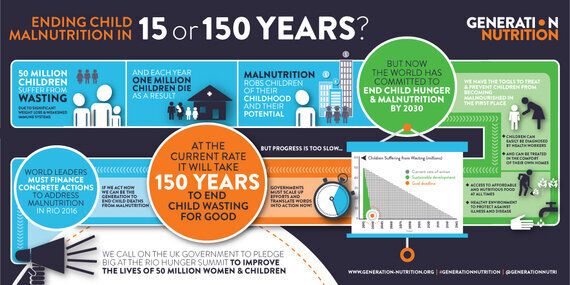I want to be part of the generation that witnesses the elimination of child malnutrition. And I very well could be. But if things continue as they are, it's more likely to be my great-great granddaughter who witnesses this historical moment rather than myself.
Last month, at the Sustainable Development Goal Summit, 193 countries unanimously committed to end child hunger and malnutrition by 2030. But will they collectively do what it takes to get the job done or will the world completely miss the mark?
As the gavel went down, the United National General Assembly erupted into thunderous applause. After years in the making, global goals to end extreme poverty and hunger were finally agreed. Time to breathe a sigh of relief. The hard part was done. Now we can sink back into our normal routines, right? Not even close.
The gavel should be seen as a pistol: a starting pistol signalling the start of the race to zero, but also a shot from a lethal weapon that has killed off 'business as usual' development. The world has made promising progress on malnutrition, but with such a rightly ambitious agenda 'business as usual' policies and programmes will no longer cut it. Especially when you consider the level of devastation malnutrition continues to cause.
Malnutrition can manifest in a number of ways, but the effects are similar. Malnourished children's bodies struggle to do normal things, including grow and resist disease. These children lose the ability to do what children do best - play and learn - because their bodies become so weak. Physical activity becomes almost impossible and their ability to learn and develop in school suffers. Essentially, malnutrition locks children in a cycle of poverty and poor health.
What's more, progress has not been evenly made across all forms of malnutrition. Since 1990, acute malnutrition rates have declined three times more slowly than those of chronic malnutrition, decreasing by 11% and 35% respectively. Today an estimated 50 million children suffer from acute malnutrition, the most deadly form of the condition, which is caused by severe and rapid weight loss and a weakened immune system.
Most worrying perhaps, and the reason we must do away with 'business as usual', is that based on the rate of progress during the last 25 years, it could take a further 150 years to end acute malnutrition in children for good.

The world can do better. The world must do better. There's no excuse. Especially since we know what it takes to treat malnourished children and prevent the condition occurring in the first place. Revolutionary therapeutic foods can revive even the most malnourished child in a matter of weeks, and the community and those caring for these children can now become active participants in their rehabilitation by treating children at home. Improving access to affordable and nutritious food, as well as access to clean water, sanitation and health care, helps safeguard children against becoming malnourished. You see, we have the tools to ensure that every child is able to live happy, healthy lives and reach their full potential. So what needs to happen next?
While the world has done an amazing job to reach a global commitment to end malnutrition and to do so within 15 years, we need more than targets and commitments. As governments are gearing up towards implementation, it's time to invest in more and better action - programmes and policies that put the nutritional needs of children first. And we need far more resources.
In August 2016, presidents and prime ministers from all over the world gather in Brazil for the Nutrition for Growth Summit, which takes place alongside the 2016 Rio Summer Olympics. This is the next big opportunity to ensure the finances needed to eliminate child malnutrition are in place - currently only around one per cent of Official Development Assistance goes to basic nutrition, despite malnutrition contributing to 45 per cent of preventative child deaths.
As the hosts of the first Nutrition for Growth summit in 2013, next year's summit offers a unique opportunity for the UK to show it intends to continue leading the fight to end child malnutrition. So far, the UK Government has committed to improve the nutrition of 50 million women and children by 2020. In August I hope to see David Cameron demonstrating how the UK plans to finance this commitment and do all it can to ensure the global goal to end child malnutrition will be achieved by 2030.
If we get this right, my great-great-granddaughter won't be witnessing the end to malnutrition, I will. And so will you.